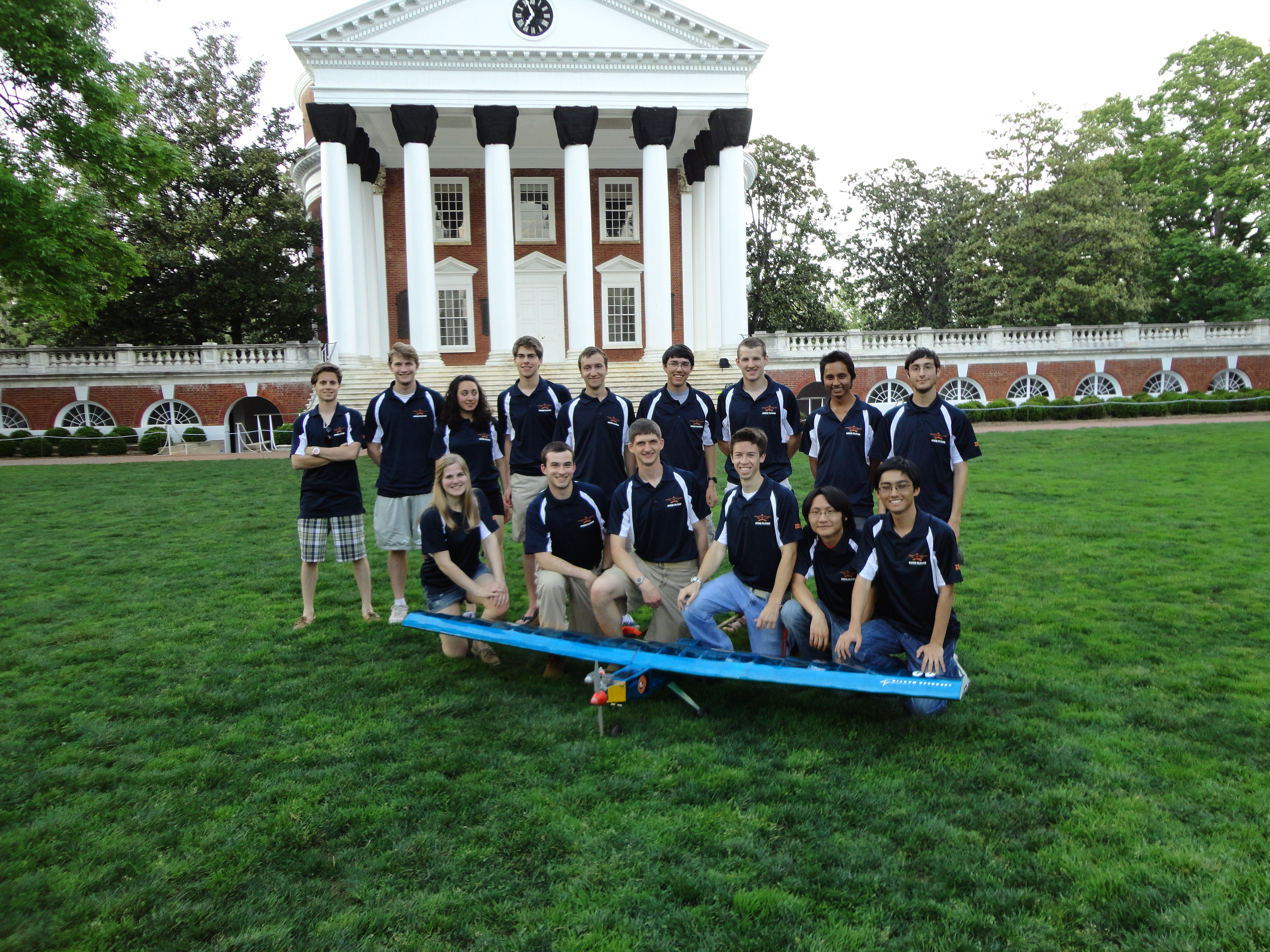May 21, 2012 — In the depths of the University of Virginia's Mechanical and Aerospace Engineering Building, a "Flying Panda" was born this year. Named for its innovative use of bamboo components, this high-performance, remote-control airplane – weighing only 11 pounds, but capable of carrying 25 pounds of payload – was designed and built by a student group known as Hoos Flying to compete in the Society of Automotive Engineers' Aero Design competition.
Led by then-fourth-year and now graduated aerospace engineering major Thomas Niskanen, and assisted by their faculty advisers from the School of Engineering and Applied Science, materials science professor George Cahen and mechanical and aerospace professor Lloyd Barrett, the team spent most of the fall semester evaluating various design options, building on previous years' experience – U.Va. teams have been competing since the 2007-08 academic year – while remaining within the strict parameters of the competition rules.
Choosing to participate in the "regular class," the team set out to design a model aircraft that could carry as much weight as possible while making one successful, controlled lap of an airfield. The craft was limited in size to no more than 225 inches of combined length, width and height and the use of a standardized engine with a 0.61-cubic-inch displacement that burns a mixture of nitromethane and castor oil.
"Due to these constraints, the design phase was an exercise in both creativity and optimization," Niskanen said. "We sought to make a craft that was both durable and extremely lightweight while also oriented toward producing as much lift as possible in order to take a heavy cargo aloft."
The team settled on the unique and innovative feature that inspired the plane's name: a bamboo tail boom. "This feature took advantage of bamboo's naturally high strength-to-weight ratio and low cost while avoiding the competition's restriction on the use of man-made, fiber-reinforced materials such as carbon fiber and fiber-reinforced plastics," Niskanen explained.
For the remainder of the plane's structure, the team chose thin modeling plywood for high stress areas and a combination of basswood and balsa for other sections. The group produced a complete computer mock-up of the design as well as a model of all the parts that would constitute the fuselage, wing and tail sections.
"We fed these images directly into laser cutters that precisely cut the specified part out of the desired material using a carbon dioxide laser," Niskanen said.
With these components in hand, the team was able to perform the intricate assembly of the 9-foot-wide wing's many ribs, the balsa tail components, and the fuselage segments designed to interlock like pieces of a jigsaw puzzle. After the frame took shape, a drum-tight, translucent blue-and-orange covering was applied to the frame of the wing, fuselage and tail to ensure a smooth and airworthy surface while allowing the complex design to remain visible from the outside.
After stable and successful flight tests carrying approximately half the projected maximum payload, nine members of the 15-person team, along with Cahen and Barrett, headed to the competition, held April 27-29 at a remote control airfield outside of Marietta, Ga.
Hoos Flying competed against 39 other teams from as far away as Poland and Winnipeg, Manitoba. Many had several times more members than Hoos Flying; some competed as part of their coursework, while U.Va.'s team was purely extracurricular.
"Over the several flight rounds spanning a two-day period, the Flying Panda exhibited smooth and stable performance with increasing payload," Niskanen said.
This performance was in sharp contrast to the numerous crashes and hair-raising maneuvers of many other crafts. By the end of the weekend, the U.Va. team's aircraft remained intact; Hoos Flying secured 14th position in its class, its best performance to date, Niskanen said.
While other teams lifted higher total weights and thus earned higher cumulative scores, the Flying Panda's "qualitatively excellent flight characteristics, innovative design features and attractive appearance were still cause for celebration," Cahen said. The plane proved capable of lifting its projected cargo weight admirably while indicating the importance of designing even higher lift craft in coming years.
"All involved felt that this year's showing was a success and an ideal steppingstone to even better future flights," said Niskanen, who is headed for work in the aerospace field.
Dan Flowers, a rising fourth-year aerospace engineering major, will take over leadership of the Hoos Flying team this fall, when team members will begin working on a new plane, using the Flying Panda as a departure point.
– by Preston Pezzaro
Media Contact
Article Information
May 23, 2012
/content/uva-student-team-makes-bamboo-fly

